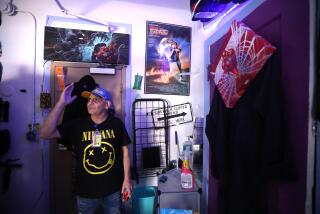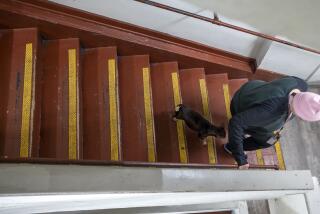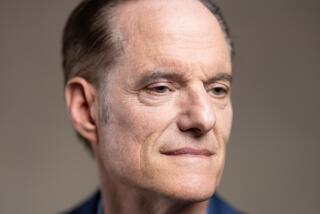Disease Challenging Volunteers, Agencies : AIDS Group Faces New Clientele
NEW YORK — A group of middle-class men, concerned that friends were dying and nothing was being done, met in Greenwich Village eight years ago.
They called themselves Gay Men’s Health Crisis. They had little money and less clout; there was no name for the disease that brought them together.
Today, Gay Men’s Health Crisis has a $10-million budget, its own six-story Manhattan building and 2,000 volunteers, and the disease has a name: acquired immune deficiency syndrome.
Challenge Changes
After years of hectoring politicians and public health officials to address the problems of people with AIDS, GMHC and its cohorts are themselves being challenged to cope with the changing face of that population.
Nationwide, more than 87,000 cases of AIDS have been reported, about two-thirds of them among homosexual or bisexual men. But in many cities, especially along the East Coast, someone diagnosed with AIDS today is about as likely to have become infected by shooting up with dirty needles as through sex.
In New York City, intravenous drug abusers totaled an estimated 45% of all newly reported AIDS cases last year. “These projections bear out what we have long known, that the spread of AIDS is fueled by drugs (and) that AIDS is accelerating its onslaught upon poor, drug-ravaged neighborhoods and minority communities,” said city Health Commissioner Stephen Joseph.
In New Jersey, IV drug abusers made up 59% of new AIDS cases.
What this means to AIDS-service providers is only now being addressed.
San Francisco, with the most people with AIDS per capita of any U.S. city, wins praise from all quarters for its response to the epidemic.
70 on Staff
Its Shanti Project, a peer-counseling group for the terminally ill, had one staffer in 1982 and was nearly defunct. Now it has a $3-million budget and a paid staff of 70, directing counseling groups and a housing program geared toward independent living for people with AIDS.
But Greg Day, Shanti’s education director, notes that about 96% of AIDS cases in the city are among gay males “who used to lead relatively normal lives,” were employed full time and have a firmer footing in society.
“I think that because the impact of AIDS has been primarily, overwhelmingly, on the gay community thus far, we have succeeded so far in developing our resources along with the epidemic,” he said. “We don’t have the answers yet on how to best serve the IV drug-user population.”
The situation is similar in Los Angeles, Seattle, Minneapolis and other cities where the number of IV drug users is relatively small, experts say.
In Chicago, things are more difficult.
“What we’re dealing with here in Chicago, particularly when we’re dealing with the issue of homelessness and destitution, is not the gay community, but blacks, minorities, IV drug users, prostitutes and their families--people of the streets basically,” said Al Mascia of Travelers and Immigrants Aid, a private group that helps house homeless people with AIDS.
Different Population
“While we want to adopt some of the programs or utilize some of the models that San Francisco has, we’re talking about working with a different population for the most part,” Mascia said.
Part of the problem is that an IV drug user does not automatically kick the habit when diagnosed with AIDS. But most AIDS organizations require infected drug abusers to enter treatment before they are accepted as clients.
“It’s fine for us to deal with you as someone with ARC (AIDS-related complex) or AIDS,” said Tim Sweeney, GMHC deputy director for policy. “But the truth is if you’re just leaving our front door and going out and sticking another needle in your arm, we’re really not doing you any big favor.
“You’ve got two illnesses to be dealt with.”
Programs such as GMHC and the Shanti Project depend on volunteers, but Sweeney said, “We are finding now that . . . the volunteer model really doesn’t work with them. They need much more direct, intense case management, much more involvement, usually by a professional staff person to help them set up the structure of their life, so that they’re independent.”
The drug abuser also is more likely to be homeless, yet shelters are no place for someone infected with AIDS. Several cities run apartments for people with AIDS capable of independent living, but demand far outstrips supply.
No Place to Go
People with AIDS who no longer need hospitalization but have no place to go often are sent to single-room-occupancy hotels, where they have no medical supervision and must contend with seedy surroundings and crime.
Many are “discharged from the hospital and can sit on the bench out front,” said Larry Ellis of Lifelink, a Washington-based AIDS organization.
In New York, a lucky few find room in the highly praised, privately run Bailey House, the city’s only supervised AIDS residence. It opened in 1986 with rooms for 44 people and hopes to add nine more rooms by the summer of 1990.
For Lawrence Conklin, 38, a 20-year heroin and cocaine addict diagnosed with AIDS about two years ago, a clean, nicely furnished room at Bailey House and a treatment program “was the only thing that saved me.”
Yet even Bailey House has evicted several residents because of drug-related problems, said its administrator, Gordon Hough.
Double Punishment
“We consider ourselves a humane society, and I don’t think we should doubly punish a person who’s already suffering,” said Diane Doherty, a member of the National Coalition for the Homeless board.
“I would be hard pressed to make the argument that every single program has to accept people who . . . ‘go off the wagon.’ Perhaps what we need, maybe, is a house in a community where people who cannot stop have a place to go.”
GMHC also wants to see a range of services targeted at specific populations, but Sweeney said his organization, despite its position as the nation’s largest private AIDS-service organization, can’t be expected to be all things to all people. Gay and bisexual men still make up 80% of GMHC’s caseload of 2,500 HIV-infected people, and “just taking care of that burden alone is extremely daunting,” he said.
Some former volunteers and other AIDS activists have criticized GMHC for, among other things, not sharing more of its resources with smaller groups, but Sweeney said GMHC doesn’t want to appear arrogant.
“We’re real conscious of our limitations. We believe in empowerment. We believe in communities taking care of themselves and getting the resources and asserting their own leadership. . . .
“The future is to get a bigger pie and to get other people involved with the disease. . . . A lot of the policy and advocacy work that we’re doing is around this issue of budgets and getting money out to communities who don’t have the access and the political organizing skills that we do. . . .
“I think we are around for a much longer fight than maybe some people anticipated,” Sweeney said.
More to Read
Sign up for Essential California
The most important California stories and recommendations in your inbox every morning.
You may occasionally receive promotional content from the Los Angeles Times.










